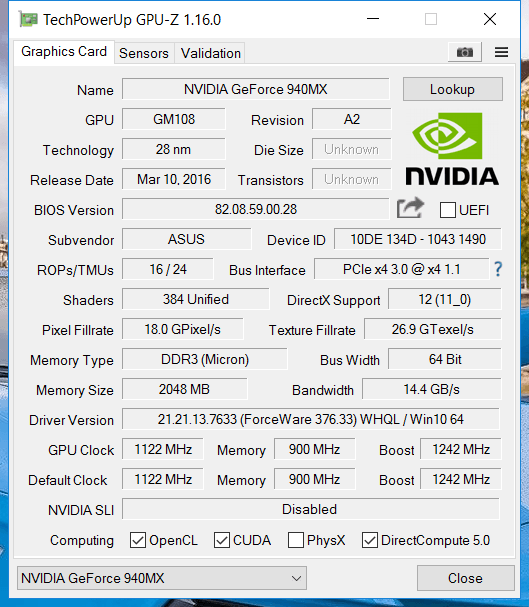
- 940mx intel graphic card benchmark upgrade#
- 940mx intel graphic card benchmark full#
- 940mx intel graphic card benchmark code#
- 940mx intel graphic card benchmark series#
HD-Audio codecs, such as Dolby TrueHD and DTS-HD, can be transmitted via bitstream mode through the HDMI port.

Furthermore, high resolution monitors of up to 3840x2160 pixels can now be connected using DisplayPort 1.2 or HDMI 1.4a if available. This includes support for up to 4 active displays. The feature set of the 920M corresponds to the GT 730M and 825M. For comparison, a GeForce 930M is about 20 to 30 percent faster than the 920M. The GeForce 920M offers a performance similar to the AMD Radeon R7 M260 or R7 M360 and will handle modern games (as of 2014/2015) in low settings only.
940mx intel graphic card benchmark series#
PCIe 3.0 is now supported by the mobile Kepler series and GPU Boost 2.0 mode can automatically overclock the card if the laptop cooling system allows it. This feature is available on any notebook with a graphics card from the 800M series. Furthermore, the GK208 chip has 16 TMUs and 8 ROPs on a 64-bit memory interface. GK208 is based on the Kepler architecture and offers two shader blocks, called SMX, each with 192 shaders for a total of 384 shader cores. The shaders are clocked at the same speed as the rest of the chip. The 384 shaders are clocked at 954 MHz, while the memory (64-bit DDR3 interface) runs at 900 MHz (1800 MHz effective). It is based on the 28 nm Kepler architecture and uses the same GK208 chip as the GeForce GT 730M, 825M and 740M. The NVIDIA GeForce 920M (sometimes also NVIDIA GeForce GT 920M) is an entry level DirectX 12 graphics card. HDMI 2.0 will also be fully supported. New technologies such as Dynamic Super Resolution, Third Generation Delta Color Compression, Multi-Pixel Programming Sampling, Nvidia VXGI (Real-Time-Voxel-Global Illumination), VR Direct, and Multi-Frame Sampled Anti-Aliasing(MFAA) were recently introduced and should be fully compatible with the new chips.NVIDIA GeForce 920M ► remove from comparison

940mx intel graphic card benchmark full#
Full fixed function HEVC hardware based decoding should also now be supported. They will also support encoding resolutions at 1440p/60FPS & 4K/60FPS compared to Maxwell 1.0 architecture which only supported H.264 1080p/60FPS encoding. It would also mean that these chips support DirectX 12 to a much greater degree ( upto feature level 12_1 as opposed to feature level 12_0). Which would mean a slight increase in IPC as well with the same core count. Remember the story that revealed Nvidia is running out of Maxwell 1.0 chips? Well, if that is true than these new GPUs could very well be on Maxwell 2.0. Interestingly, the source mentions that this time around, even the Geforce 920MX will be Maxwell, which raises an interesting possibility. A cut variant of the GK108 is found in the Geforce 920M whileas the GM108 chip can be found in Geforce 930M and 940M. The architecture of the Geforce 920M, and, Geforce 930M and Geforce 940M, was Kepler and Maxwell 1.0 respectively.
940mx intel graphic card benchmark code#
There is also a low power version of the Geforce 930MX present which will sip only 5-12W depending on the scenario and is code named N16S-LP. The wattage of these chips will be around 15-25W.
940mx intel graphic card benchmark upgrade#
Naturally this is something that will vary across games, still, the performance boost from the memory upgrade is very much real. T he difference in memory results in an easy 24% performance boost in Bioshock Infinite. Take for example the benchmark above, showcasing a DDR3 based Geforce 940M and a GDDR5 1 GB Geforce 940M.

Note for eg that the GDDR5 version of the current Geforce 940M in the Surface Book can make as much as a ~20% difference compared to its DDR3 version. This can be as high as ~20% in some cases.

It’s worth adding that even though we won’t be seeing an increase in core count or a different architecture the inclusion of GDDR5 support will result in significantly increased performance. The codenames are N16V-GMR, N16S-GMR and N16S-GTR respectively for the 920MX, 930MX and 940MX. The new chips will arrive in the first few months of 2016 and will be more efficient revisions of the same chips. Nvidia refreshing low to mainstream Geforce Mobility lineup with new chips and GDDR5 memory support The primary difference between the two generations (known so far) will be optional GDDR5 support present with MX series GPUs. The new generation will be donated by an additional ‘X’ suffix so that the nomenclature becomes Geforce 920MX, Geforce 930MX and Geforce 940MX respectively. Nvidia seems to be undergoing a refresh cycle on the mobility side of things because a report from NotebookCheck indicates that new versions of the Geforce 920M, Geforce 930M and Geforce 940M are in the pipeline.


 0 kommentar(er)
0 kommentar(er)
